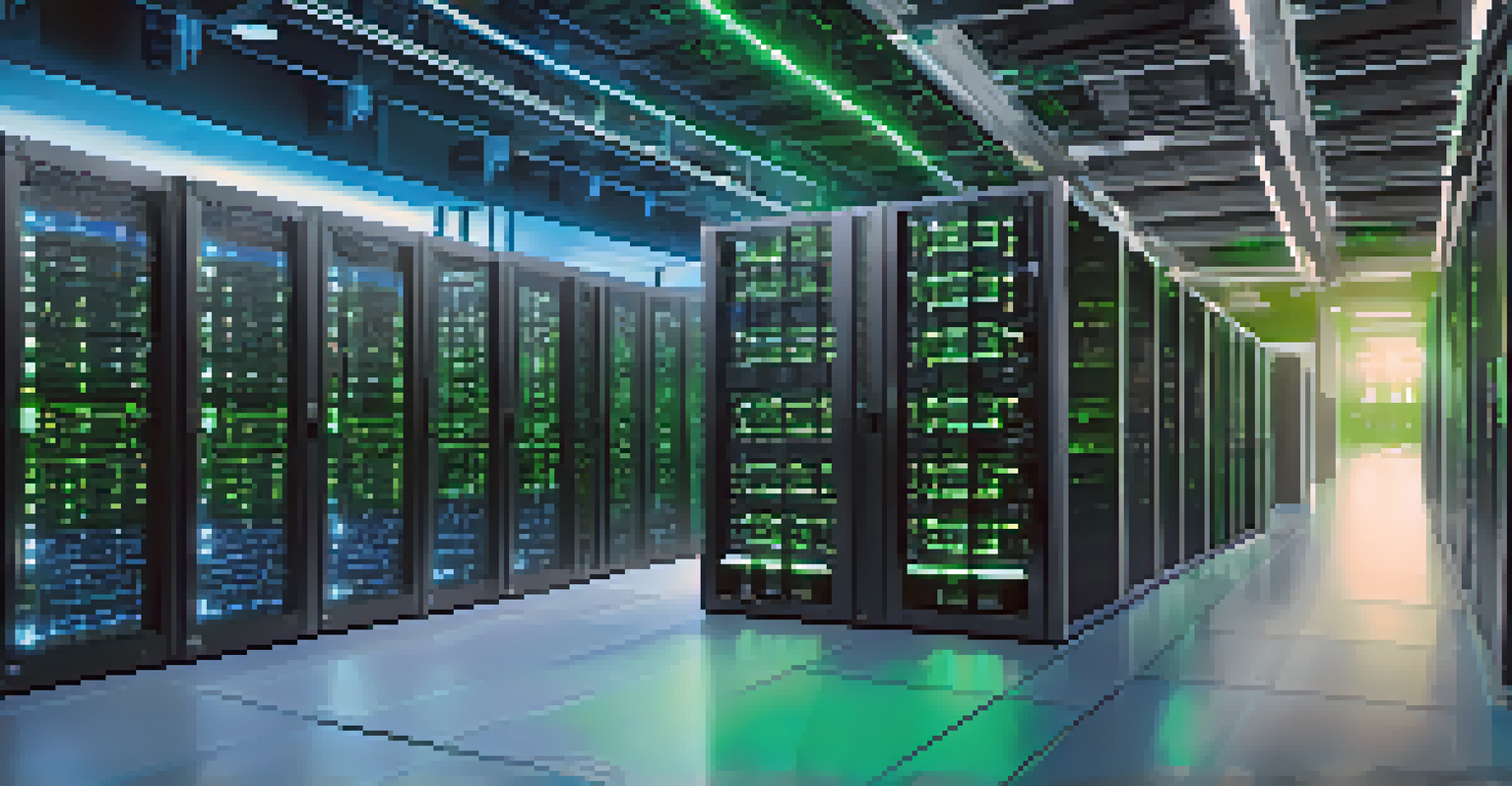The Impact of Edge Computing on Cloud Services and Performance

Understanding Edge Computing: A Brief Overview
Edge computing refers to the practice of processing data closer to where it is generated, rather than relying solely on centralized cloud data centers. This approach reduces latency, enabling faster data transmission and better real-time processing. Imagine a smart thermostat that makes immediate adjustments based on local temperature readings, rather than sending data to a far-off server for analysis.
The future is already here — it's just not very evenly distributed.
The shift towards edge computing has been driven by the rise of IoT devices, which generate massive amounts of data requiring quick decision-making. With edge computing, data can be analyzed on the spot, resulting in quicker responses and enhanced user experiences. For example, in autonomous vehicles, real-time data processing is crucial for safety and efficiency.
Furthermore, edge computing complements cloud services by offloading some of the computational tasks, allowing cloud resources to focus on larger, more complex data sets. This synergy not only improves performance but also optimizes resource allocation, making systems more efficient overall.
How Edge Computing Enhances Cloud Services
By processing data at the edge, organizations can significantly reduce the amount of data sent to the cloud, leading to lower bandwidth usage and costs. This is particularly beneficial for businesses that rely on large volumes of data but require quick insights for operations. Think of a retail chain analyzing customer foot traffic; edge computing allows them to react instantly without overwhelming the cloud with data.

Moreover, edge computing can enhance cloud services by providing backup and redundancy. In scenarios where connectivity to the cloud is limited or disrupted, edge devices can continue functioning independently, ensuring that critical operations remain uninterrupted. This resilience is vital in sectors like healthcare, where constant access to data can be life-saving.
Edge Computing Reduces Latency
By processing data closer to its source, edge computing significantly decreases latency, enabling faster responses in applications like autonomous vehicles and video gaming.
Additionally, integrating edge computing with cloud services enables organizations to maintain compliance with data privacy regulations. By processing sensitive information locally, businesses can minimize the risk of data breaches while still leveraging the cloud for non-sensitive tasks.
The Role of Latency in Performance Improvement
Latency, or the delay before data transfer begins, can heavily impact user experience, especially in applications requiring real-time feedback. Edge computing reduces latency by processing data closer to the source, allowing for quicker responses. For instance, in video gaming, lag can ruin the experience, but edge computing ensures data is processed in milliseconds, keeping gameplay smooth.
Data is the new oil, and understanding how to process it efficiently is key to success.
Improved latency also benefits industries like finance, where split-second decisions can lead to significant gains or losses. By utilizing edge computing, financial institutions can analyze stock market data in real-time, allowing traders to make informed decisions faster than ever. This speed can be the difference between capitalizing on an opportunity or missing it.
Moreover, as more applications move towards augmented and virtual reality, the need for low-latency solutions becomes even more critical. Edge computing can provide the necessary infrastructure to support these advanced technologies, enhancing performance and user satisfaction.
Data Security Implications of Edge Computing
Security is a major concern when it comes to cloud services, and edge computing introduces both challenges and opportunities. By processing data locally, sensitive information can be kept on-site, potentially reducing exposure to cyber threats. This localized processing can be particularly beneficial for industries dealing with sensitive data, such as finance and healthcare.
However, with more devices and endpoints comes the need for robust security measures. Each edge device can become a potential vulnerability, making it essential for organizations to implement strong security protocols. This can include encryption, access controls, and regular updates to protect against potential breaches.
Cost Savings with Edge Computing
Organizations can achieve cost efficiency by minimizing data transmission to the cloud, allowing for effective resource allocation between edge and cloud computing.
Additionally, edge computing allows for the implementation of security measures closer to the data source. This proactive approach can help identify and mitigate threats in real-time, rather than waiting for centralized systems to respond. Ultimately, a dual approach that combines edge and cloud security strategies can create a more resilient infrastructure.
Cost Efficiency: Balancing Edge and Cloud Resources
One of the primary advantages of edge computing is its potential for cost savings. By processing data locally, organizations can reduce the volume of data transmitted to the cloud, leading to lower bandwidth costs. Companies can allocate their resources more effectively by balancing edge and cloud computing, ensuring they only use cloud resources when absolutely necessary.
Moreover, edge devices can offload computational tasks from the cloud, enabling companies to minimize their reliance on expensive cloud processing power. This allows businesses to manage their operational costs more effectively while ensuring high performance in their applications. For instance, a manufacturing plant can analyze machine data on-site without incurring hefty cloud fees.
However, investing in edge infrastructure requires careful consideration. Organizations must assess their specific needs to determine the right balance between edge and cloud computing. A well-planned strategy can lead to significant cost savings and improved performance, ultimately benefiting the bottom line.
Future Trends in Edge Computing and Cloud Services
As technology continues to evolve, the relationship between edge computing and cloud services will likely deepen. We can expect to see advancements in artificial intelligence (AI) and machine learning (ML) that leverage edge computing for faster processing and improved decision-making. For instance, AI algorithms can analyze data locally, providing real-time insights without the need for cloud intervention.
Moreover, the growing adoption of 5G technology will further enhance the capabilities of edge computing. With its ultra-low latency and high-speed connectivity, 5G will enable more devices to process data at the edge seamlessly. This will open new avenues for innovation, particularly in industries like smart cities and autonomous vehicles.
Enhanced Data Security Measures
Edge computing allows for localized data processing, which can reduce exposure to cyber threats while requiring robust security protocols for each edge device.
As organizations increasingly recognize the benefits of edge computing, we can expect a shift in how they design their IT infrastructures. The future will likely see a hybrid approach, combining the strengths of both edge and cloud computing to create more agile, efficient, and responsive systems.
Conclusion: The Synergy of Edge Computing and Cloud Services
In conclusion, edge computing is transforming how organizations approach data processing and cloud services. By bringing computation closer to the data source, businesses can achieve lower latency, enhanced security, and cost savings. This shift not only improves performance but also enables companies to stay competitive in an increasingly digital landscape.
The synergy between edge and cloud computing creates a powerful framework for innovation, allowing organizations to harness the strengths of both technologies. As we move forward, embracing this hybrid approach will be essential for businesses looking to maximize efficiency and responsiveness.

Ultimately, the integration of edge computing with cloud services represents a significant leap forward in how we manage and analyze data. By understanding and leveraging this relationship, organizations can unlock new opportunities for growth and success.